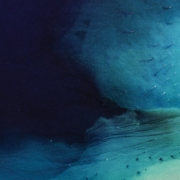‘More Blue’: An Artwork Shows the Sea Changing During Lockdown
A data-driven media installation, created to reflect marine conditions around the world, has altered with the slowing human activity.
What impact does human behavior have on the Earth’s waters? Two London-based architects, working with scientists and environmentalists, attempted to create a visual answer to that question for an art exhibition in Italy. Before the coronavirus, the 30-screen multichannel media installation was scheduled to open in March at the Ocean Space art center in the Church of San Lorenzo in Venice.
The installation, “Territorial Agency: Oceans in Transformation,” created by John Palmesino and Ann-Sofi Ronnskog, would have featured works bringing together many streams of data on activity in the world’s oceans — animal migration patterns, deep-sea mining, shipping routes, fishing — to create what the two architects call “dynamic paintings.” The digital works, shown on monitors about six feet tall, look like colorful abstract paintings marked with dots and vectors and constantly changing colors that reflect the shifting ocean conditions.
The displays were being installed when Italy’s coronavirus lockdown was announced in February, forcing the curatorial team to close up and head home. At the same time, with the sudden absence of cruise ships and tourist traffic, the Venetian lagoon began its own transformation — an eerie, real-life echo of what the art installation was attempting to document.
“You can see the bottoms of the canals,” Alice Ongaro Sartori, the program coordinator at Ocean Space, said in a phone interview from quarantine in Venice last month. “This is something I’ve never seen in my life. You can see fish, and there is a change in the color and transparency of the canals.”
The city’s newly clean waters became a symbol of the change taking place in nature. Since the lockdown, squid, octopus, jellyfish, sea turtles and even dolphins have all been sighted around Venice, said Georg Umgiesser, a senior scientist at the Institute of Marine Sciences in Venice.
Mr. Palmesino and his collaborators noticed the change in their artwork, too. “In the coastal areas, particularly in the lagoons, estuaries and other shallow waters around the world, you start to see lighter colors,” he said in a telephone interview from his own lockdown in Finland.
“The color range has become more blue, and less brownish,” he added. “The other things we’ve noticed is the change in the patterns of maritime activity, the dots that move in the ocean. Even in this short time, it is noticeable.”
“Oceans in Transformation” was opened as a digital exhibition on May 20, presenting some video elements of the works and the research behind the project.
To mark the opening, Ocean Space installed a light-based artwork called “When Above …” on the facade of the Church of San Lorenzo. It is a simple, minimalist piece: a line of LED light marking the spot where scientists predict the lagoon will rise to because of climate change. If the waters rise to that level, 19 feet higher than now, the ground story of most Venetian houses will be submerged in 100 years.
The online show is accompanied by a program of live online discussions, performances and lectures with speakers on climate change, science and urban planning. Many of the participants have reflected on how the severe slowdown of human activity caused by lockdowns could help alter the trajectory of climate change.
Markus Reymann, the director of TBA21-Academy, an arts and ecology foundation that commissioned the exhibition, said, “Now it’s for the world to see what is happening, around Venice, such an iconic city that has been struggling so much under the cruise ships and the masses of tourists and gas emissions. When it stops, there are dramatic changes, there’s quiet, there’s regeneration.”
Venice has long been on the front lines of the climate crisis. In the last two years, the city has seen the direct impact of rising global sea levels, with six major floods known as “exceptional high water events,” when the sea levels rose above 55 inches.
“In the last 150 years, we only had 24,” of those events, Mr. Umgiesser said. “A quarter of them were in the last two years, and that gives us an indication that something is changing.”
As Italy emerges from one of the strictest lockdowns in Europe, cultural institutions are beginning to open up, with new social distancing measures in place. The Ocean Space arts center plans to reopen to the public on Aug. 27, so visitors can see the exhibition as it was originally intended.
Mr. Palmesino said he hoped that seeing the work in person would have an even greater emotional impact and spur action. “If you would make the right decisions to quickly move to reducing burning oil and gas and coal,” he said, “we would have these effects that are obviously positive for the seas and the environment.”
Jeremy Jackson, an emeritus professor at the Scripps Institution of Oceanography in San Diego who was a consultant on the project, said that the few months of respite from human activities would not alter our path toward disaster, if unaccompanied by further actions.
“It’s safe to say that the dial of the climate crisis is not turned back,” Mr. Jackson said. “We just get a hint of what could happen if we decided to go in this direction.”
Source: nytimes.com




